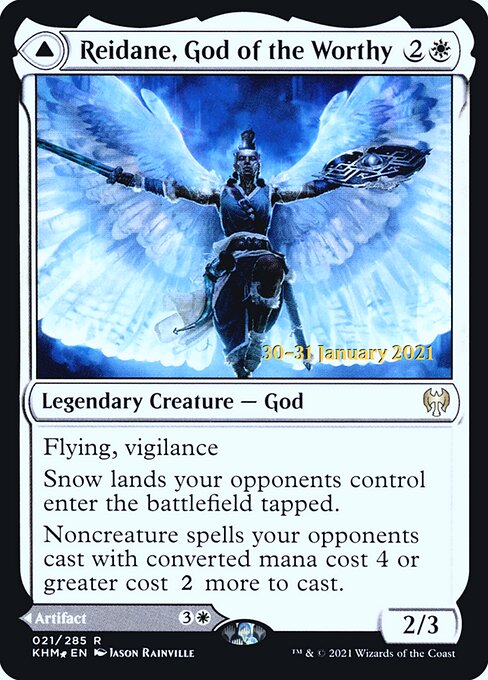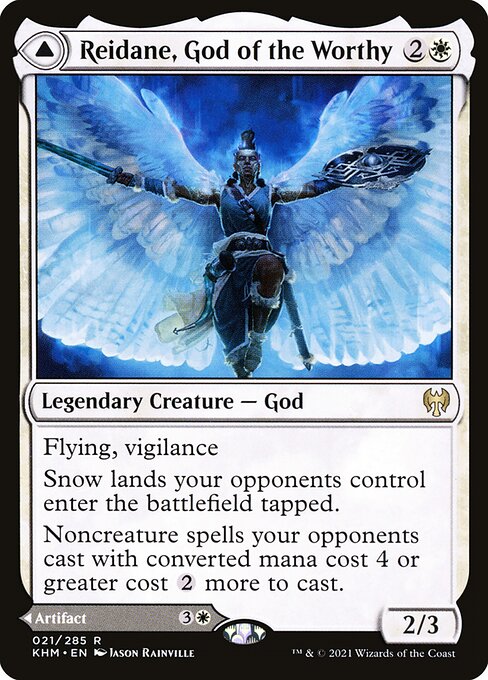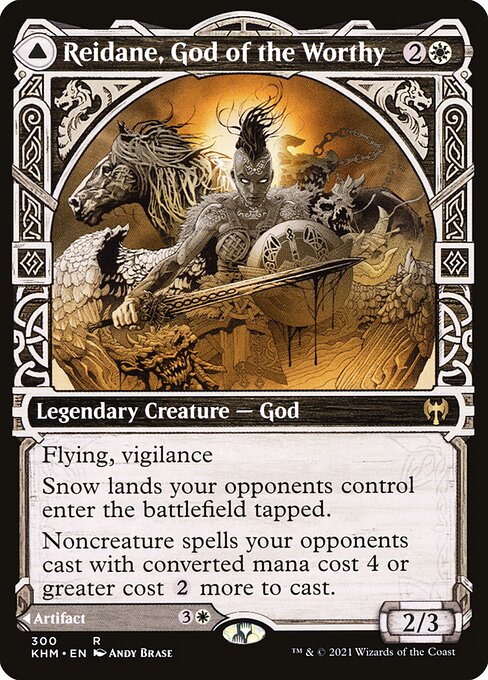Reidane, God of the Worthy // Valkmira, Protector's Shield
//
Legendary Creature — God // Legendary Artifact
Flying, vigilance
Snow lands your opponents control enter the battlefield tapped.
Noncreature spells your opponents cast with mana value 4 or greater cost more to cast. // If a source an opponent controls would deal damage to you or a permanent you control, prevent 1 of that damage.
Whenever you or another permanent you control becomes the target of a spell or ability an opponent controls, counter that spell or ability unless its controller pays .
Snow lands your opponents control enter the battlefield tapped.
Noncreature spells your opponents cast with mana value 4 or greater cost more to cast. // If a source an opponent controls would deal damage to you or a permanent you control, prevent 1 of that damage.
Whenever you or another permanent you control becomes the target of a spell or ability an opponent controls, counter that spell or ability unless its controller pays .
2/3
standard
future
historic
gladiator
pioneer
explorer
modern
legacy
pauper
vintage
penny
commander
brawl
alchemy
paupercommander
duel
oldschool
premodern
Rulings
If an effect allows you to play a specific modal double-faced card, you may cast it as a spell or play it as a land, as determined by which face you choose to play. If an effect allows you to cast (rather than “play”) a specific modal double-faced card, you can’t play it as a land.
If a spell has in its mana cost, use the value of X to determine whether its converted mana cost is 4 or greater. If it is, Reidane’s last ability will apply. If not, it won’t.
Valkmira’s first ability prevents 1 damage from each source an opponent controls each time that source would deal damage to you. It prevents 1 of any kind of damage, not just combat damage.
A modal double-faced card can’t be transformed or be put onto the battlefield transformed. Ignore any instruction to transform a modal double-faced card or to put one onto the battlefield transformed.
To determine whether it is legal to play a modal double-faced card, consider only the characteristics of the face you’re playing and ignore the other face’s characteristics.
Valkmira’s last ability affects each spell (including Aura spells), activated ability, and triggered ability controlled by an opponent that targets you or another permanent you control.
If an effect instructs a player to choose a card name, the name of either face may be chosen. If that effect or a linked ability refers to a spell with the chosen name being cast and/or a land with the chosen name being played, it considers only the chosen name, not the other face’s name.
There is a single triangle icon in the top left corner of the front face. There is a double triangle icon in the top left corner of the back face.
In the Commander variant, a double-faced card’s color identity is determined by the mana costs and mana symbols in the rules text of both faces combined. If either face has a color indicator or basic land type, those are also considered.
If an effect puts a double-faced card onto the battlefield, it enters with its front face up. If that front face can’t be put onto the battlefield, it doesn’t enter the battlefield.
If an effect allows you to play a land or cast a spell from among a group of cards, you may play or cast a modal double-faced card with any face that fits the criteria of that effect.
The converted mana cost of a modal double-faced card is based on the characteristics of the face that’s being considered. On the stack and battlefield, consider whichever face is up. In all other zones, consider only the front face. This is different than how the converted mana cost of a transforming double-faced card is determined.
To determine the total cost of a spell, start with the mana cost or alternative cost you’re paying, add any cost increases (such as that of Reidane, God of the Worthy), then apply any cost reductions. The converted mana cost of the spell is determined only by its mana cost, no matter what the total cost to cast the spell was.
If a spell has in its mana cost, use the value of X to determine whether its converted mana cost is 4 or greater. If it is, Reidane’s last ability will apply. If not, it won’t.
Valkmira’s first ability prevents 1 damage from each source an opponent controls each time that source would deal damage to you. It prevents 1 of any kind of damage, not just combat damage.
A modal double-faced card can’t be transformed or be put onto the battlefield transformed. Ignore any instruction to transform a modal double-faced card or to put one onto the battlefield transformed.
To determine whether it is legal to play a modal double-faced card, consider only the characteristics of the face you’re playing and ignore the other face’s characteristics.
Valkmira’s last ability affects each spell (including Aura spells), activated ability, and triggered ability controlled by an opponent that targets you or another permanent you control.
If an effect instructs a player to choose a card name, the name of either face may be chosen. If that effect or a linked ability refers to a spell with the chosen name being cast and/or a land with the chosen name being played, it considers only the chosen name, not the other face’s name.
There is a single triangle icon in the top left corner of the front face. There is a double triangle icon in the top left corner of the back face.
In the Commander variant, a double-faced card’s color identity is determined by the mana costs and mana symbols in the rules text of both faces combined. If either face has a color indicator or basic land type, those are also considered.
If an effect puts a double-faced card onto the battlefield, it enters with its front face up. If that front face can’t be put onto the battlefield, it doesn’t enter the battlefield.
If an effect allows you to play a land or cast a spell from among a group of cards, you may play or cast a modal double-faced card with any face that fits the criteria of that effect.
The converted mana cost of a modal double-faced card is based on the characteristics of the face that’s being considered. On the stack and battlefield, consider whichever face is up. In all other zones, consider only the front face. This is different than how the converted mana cost of a transforming double-faced card is determined.
To determine the total cost of a spell, start with the mana cost or alternative cost you’re paying, add any cost increases (such as that of Reidane, God of the Worthy), then apply any cost reductions. The converted mana cost of the spell is determined only by its mana cost, no matter what the total cost to cast the spell was.
Rulings
If an effect allows you to play a specific modal double-faced card, you may cast it as a spell or play it as a land, as determined by which face you choose to play. If an effect allows you to cast (rather than “play”) a specific modal double-faced card, you can’t play it as a land.
If a spell has in its mana cost, use the value of X to determine whether its converted mana cost is 4 or greater. If it is, Reidane’s last ability will apply. If not, it won’t.
Valkmira’s first ability prevents 1 damage from each source an opponent controls each time that source would deal damage to you. It prevents 1 of any kind of damage, not just combat damage.
A modal double-faced card can’t be transformed or be put onto the battlefield transformed. Ignore any instruction to transform a modal double-faced card or to put one onto the battlefield transformed.
To determine whether it is legal to play a modal double-faced card, consider only the characteristics of the face you’re playing and ignore the other face’s characteristics.
Valkmira’s last ability affects each spell (including Aura spells), activated ability, and triggered ability controlled by an opponent that targets you or another permanent you control.
If an effect instructs a player to choose a card name, the name of either face may be chosen. If that effect or a linked ability refers to a spell with the chosen name being cast and/or a land with the chosen name being played, it considers only the chosen name, not the other face’s name.
There is a single triangle icon in the top left corner of the front face. There is a double triangle icon in the top left corner of the back face.
In the Commander variant, a double-faced card’s color identity is determined by the mana costs and mana symbols in the rules text of both faces combined. If either face has a color indicator or basic land type, those are also considered.
If an effect puts a double-faced card onto the battlefield, it enters with its front face up. If that front face can’t be put onto the battlefield, it doesn’t enter the battlefield.
If an effect allows you to play a land or cast a spell from among a group of cards, you may play or cast a modal double-faced card with any face that fits the criteria of that effect.
The converted mana cost of a modal double-faced card is based on the characteristics of the face that’s being considered. On the stack and battlefield, consider whichever face is up. In all other zones, consider only the front face. This is different than how the converted mana cost of a transforming double-faced card is determined.
To determine the total cost of a spell, start with the mana cost or alternative cost you’re paying, add any cost increases (such as that of Reidane, God of the Worthy), then apply any cost reductions. The converted mana cost of the spell is determined only by its mana cost, no matter what the total cost to cast the spell was.
If a spell has in its mana cost, use the value of X to determine whether its converted mana cost is 4 or greater. If it is, Reidane’s last ability will apply. If not, it won’t.
Valkmira’s first ability prevents 1 damage from each source an opponent controls each time that source would deal damage to you. It prevents 1 of any kind of damage, not just combat damage.
A modal double-faced card can’t be transformed or be put onto the battlefield transformed. Ignore any instruction to transform a modal double-faced card or to put one onto the battlefield transformed.
To determine whether it is legal to play a modal double-faced card, consider only the characteristics of the face you’re playing and ignore the other face’s characteristics.
Valkmira’s last ability affects each spell (including Aura spells), activated ability, and triggered ability controlled by an opponent that targets you or another permanent you control.
If an effect instructs a player to choose a card name, the name of either face may be chosen. If that effect or a linked ability refers to a spell with the chosen name being cast and/or a land with the chosen name being played, it considers only the chosen name, not the other face’s name.
There is a single triangle icon in the top left corner of the front face. There is a double triangle icon in the top left corner of the back face.
In the Commander variant, a double-faced card’s color identity is determined by the mana costs and mana symbols in the rules text of both faces combined. If either face has a color indicator or basic land type, those are also considered.
If an effect puts a double-faced card onto the battlefield, it enters with its front face up. If that front face can’t be put onto the battlefield, it doesn’t enter the battlefield.
If an effect allows you to play a land or cast a spell from among a group of cards, you may play or cast a modal double-faced card with any face that fits the criteria of that effect.
The converted mana cost of a modal double-faced card is based on the characteristics of the face that’s being considered. On the stack and battlefield, consider whichever face is up. In all other zones, consider only the front face. This is different than how the converted mana cost of a transforming double-faced card is determined.
To determine the total cost of a spell, start with the mana cost or alternative cost you’re paying, add any cost increases (such as that of Reidane, God of the Worthy), then apply any cost reductions. The converted mana cost of the spell is determined only by its mana cost, no matter what the total cost to cast the spell was.
Your collection? Your decks?
Want to manage your collection and/or create decks?



 0
0
 0.46€
0.46€
